12 Best Cheeses For A Luxurious Ham Sandwich

When it comes to the classic ham sandwich, most of us are well-acquainted with the trusty trio of cheddar, provolone, and Swiss. They're reliable and satisfying go-to options, but like any winning combo, they feel too predictable. So, whether you're looking to add a dash of excitement to your lunch or want to leave a lasting impression on your guests, it's time to explore the fancier, more flavorful side of the cheese spectrum.
Hailing from France, Italy, and even Denmark, this luxurious group of cheeses promises to transform your midday meal into a gourmet experience with little to no extra effort on your part. We're talking about the tangy allure of extra sharp cheddar, the creamy elegance of Havarti, and the melt-in-your-mouth indulgence of Brie and Camembert. But our journey doesn't stop there. Keep reading to discover all of the best cheeses for a luxurious ham sandwich. By the end, there's no way you'll see this simple sandwich the same way ever again.
Read more: 26 Best Toppings To Add To Your Chicken Sandwich
Extra Sharp Cheddar
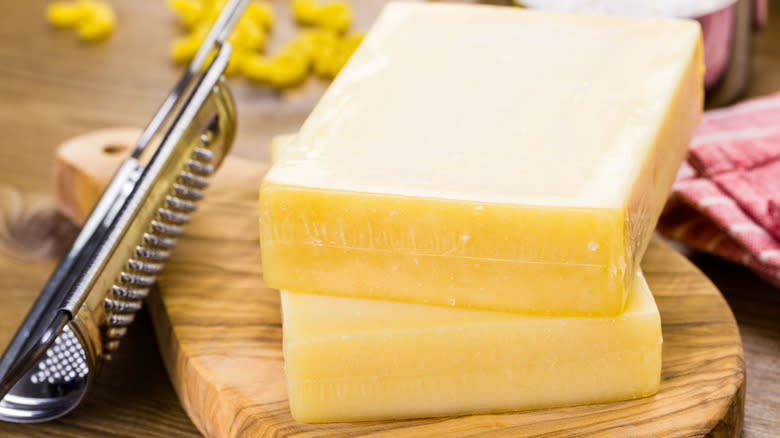
With its creamy texture and mild flavor, regular cheddar cheese is a trusty ham sandwich companion. However, when the time comes to elevate your regular sando from ordinary to opulent, you need a cheese that's a cut above the rest. Cue extra sharp cheddar. Unlike its milder counterparts, extra sharp cheddar matures for up to two years before gracing supermarket shelves. During this period, the cheese develops rich, tangy notes that are sure to tantalize your taste buds. Besides taking on a bolder flavor profile, aged cheddar cheese also develops a crunchier and crumblier texture, thanks to the formation of calcium lactate crystals. These bewitching flavors and textures are the perfect counterpoint to the sweet and salty dimensions of ham.
When pairing extra sharp cheddar with your ham, think beyond the ordinary. The flavors in this type of cheese come alive when matched with a fruity accompaniment. For instance, we're big fans of adding apple slices to ham sandwiches, along with a generous squirt of mustard. For an even more extravagant twist, try layering succulent fig slices and peppery arugula on top of the ham and cheese. No matter what ham sandwich combination you choose, you'll be well on your way to a luxurious lunch in no time.
Smoked Gouda
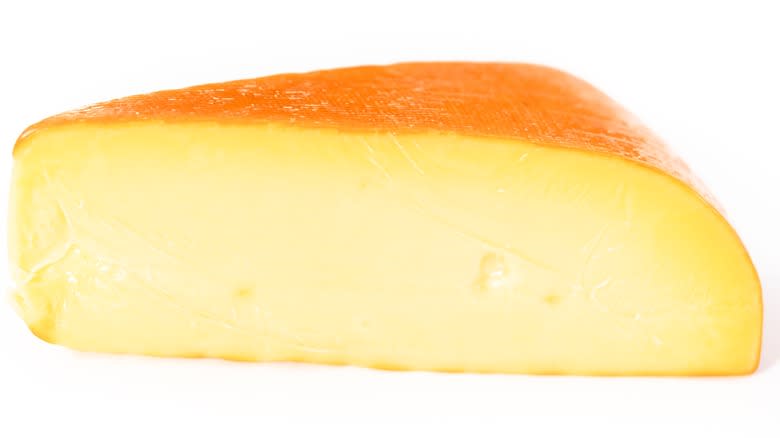
Buttery, nutty, and smooth, smoked Gouda is a cheese that will truly transform your ham sandwich. While the smooth, buttery notes are nothing to joke about, what truly sets this cheese apart is its subtle smokiness — a flavor reminiscent of the irresistible allure of bacon. The marriage of smoky bacon notes and ham is the stuff of irresistible sandwich legends. But just in case you need a nudge to explore this pairing, know that the cheese's smoky notes intertwine effortlessly with the savory essence of ham, something that will give your sandwich an unprecedented depth of flavor.
When it comes to crafting the perfect ham and smoked Gouda sandwich, the possibilities are as delightful as they are endless. One delectable option involves layering slices of smoked Gouda with ham, baby spinach leaves, and a generous squirt of honey mustard on crusty artisan bread. For something even fancier, try matching smoked Gouda with ham, frisée, and caramelized onions. Pair this ensemble with country white or sourdough bread, and you're in for a culinary delight that brings together sweet, savory, and nutty flavors.
Havarti
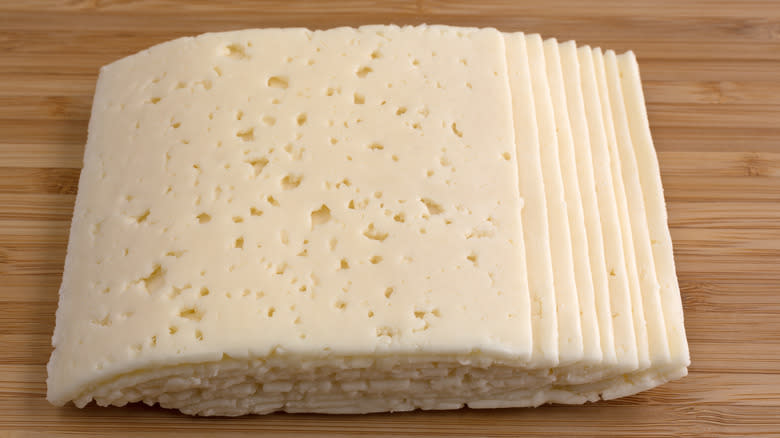
Originating from Denmark, Havarti is a creamy, semi-soft cheese poised to elevate your everyday ham sandwich into a gourmet experience. Havarti is recognizable by its springy texture and small, irregular openings known as eyes. More than a wacky feature, these tiny holes provide a captivating textural dimension. As far as flavor goes, young Havarti has the tendency to be a bit bland. However, in just three months, the cheese matures into a tangy, slightly acidic masterpiece featuring hints of hazelnut. This sweet tanginess is what makes Havarti the perfect partner for ham.
If you're in need of some recipe inspiration, consider topping Hawaiian rolls with ham, Havarti, and mayonnaise. Cover with a sauce made out of mustard, onion, poppy seeds, and Worcestershire sauce before baking. For a more traditional sandwich that's no less exquisite, slather homemade focaccia bread with apricot jam and honey. Layer Havarti and ham on top, then grill until the cheese melts.
Brie
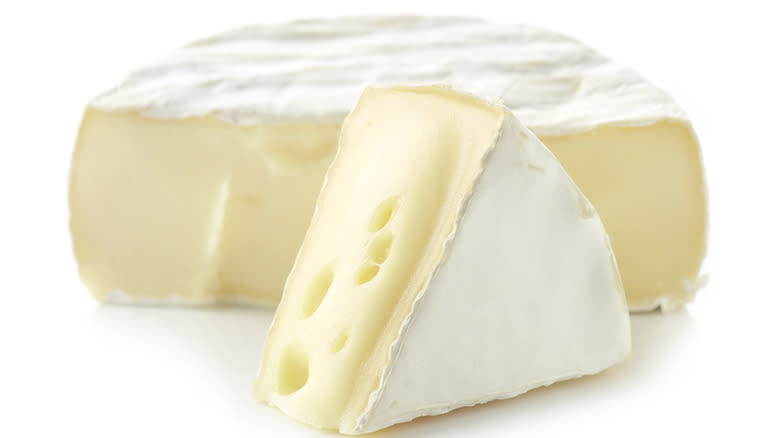
We're not usually ones to take shortcuts, but if luxury is your goal, adding something French is a surefire way to infuse fanciness into whatever dish you're eating. That's especially true when it comes to Brie, a soft, creamy cheese originating from northern France. Boasting a mild, nutty flavor and a characteristic bloomy rind, Brie tantalizes the palate with its distinctive mushroomy essence. We appreciate the combination of Brie and ham for a couple of reasons. For one, Brie's velvety texture creates a satisfying contrast with ham's chewy fleshiness. What's more, the cheese's slight earthiness gives sandwiches a sophisticated depth of flavor without overpowering the robust flavors of the meat.
For an unforgettable ham and Brie sandwich, you can't go wrong with adding slices of Granny Smith apple, a handful of arugula, and mustard aioli to a baguette. Alternatively, consider the timeless combination of Brie, pear, honey mustard, and salted butter. This beloved favorite is sure to transport your taste buds straight to a charming Parisian cafe. Both combos are delicious cold, but, if you really want to take your sandwich to the next level, we recommend grilling it until the bread takes on a rich golden brown hue and the Brie gracefully oozes from the sides of the bread.
Roquefort
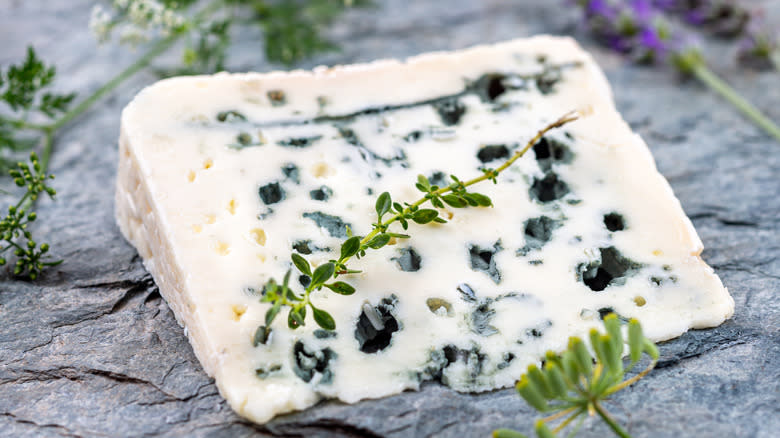
Americans often tend to categorize all moldy cheeses as simply blue cheese, but that's a bit of an oversimplification. In reality, France boasts more than a dozen distinct varieties of blue cheese, among them Saint Agur, Bleu d'Auvergne, and, of course, the renowned Roquefort. This famed cheese originates from Roquefort-sur-Soulzon, a small town in the heart of southern France. Roquefort is crafted from full-fat, unpasteurized sheep's milk. However, it's the striking blue veins, created by Penicillium roqueforti mold, that give this cheese its distinct character. Aside from providing some serious visual interest, these veins give Roquefort its bold, tangy, and slightly spicy flavor profile. All of these notes effortlessly complement the saltiness and richness of ham.
These two ingredients are also a match made in heaven on the texture front. Roquefort has a creamy, moist rind but a crumbly interior (thank those veins again). This unique texture combination not only complements the firmness of ham but also introduces an intriguing contrast that enhances the overall mouthfeel. For a memorable Roquefort and ham sandwich, consider introducing a few slices of fig to your baguette or ciabatta. Their intense sweetness helps counterbalance the robust flavors of the other ingredients, infusing your sandwich with a touch of freshness.
Gruyère
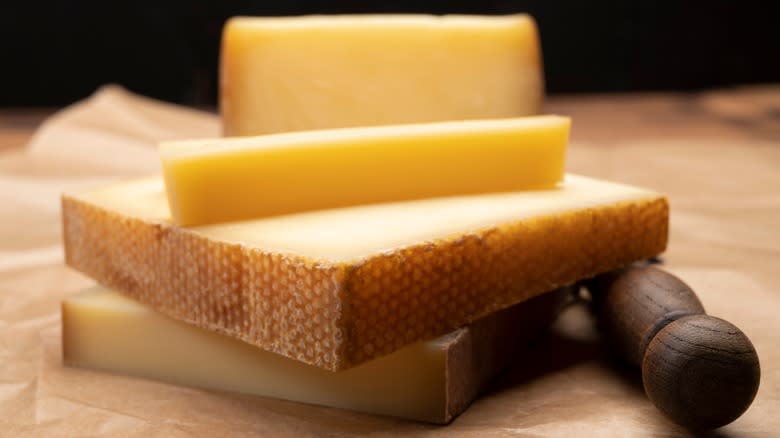
Coming from the picturesque Swiss town of Gruyères, this semi-hard cheese, crafted from whole cow's milk, distinguishes itself by its modest scattering of small holes. Its complexion is a pale shade of yellow, and its texture is firm. However, Gruyère is so much more than just its physical attributes. That's because cheese connoisseurs everywhere rely on Gruyère when it comes to crafting the perfect chicken cordon bleu, elevating fondue, and adorning French onion soup.
And let's not overlook the classic croque monsieur, that iconic French toasted ham and cheese sandwich. Given Gruyère's reputation for elevating ham and cheese pairings, it only makes sense to use it in a luxurious ham sandwich. This combination works thanks to Gruyère's subtle flavor and creamy texture. Younger Gruyère is known for its nutty notes, whereas older Gruyère takes on a complex earthiness as it ages. In both cases, the flavor profile enhances the richness of ham without overshadowing it. Another advantage of Gruyère lies in its exceptional melting capabilities, attributable to its high water-to-oil ratio. This makes it ideal for ham and cheese paninis. If you really want to Frenchify your noon meal, consider incorporating some chopped cornichons and Dijon mustard into your sandwich for that extra touch of indulgence.
Comté
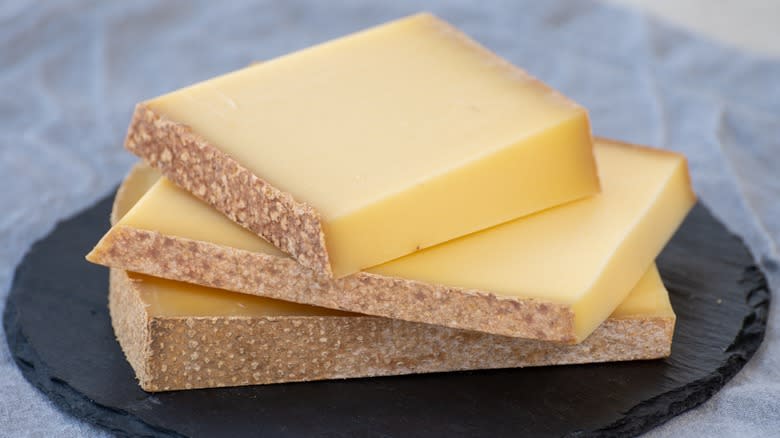
Former French general and president Charles de Gaulle once quipped that it was impossible to rule a country with 246 varieties of cheese. What he probably meant was that French people's mentalities differed just as much as their cheese preferences. While there's certainly some truth in the general's assertion, Comté stands as a beacon of consensus in the Hexagon.
Just like its home country, Comté is unique and enigmatic. At four months of aging, it's soft, supple, and carries delightful nutty undertones. As it matures, it undergoes a remarkable transformation, developing notes of celery, nutmeg, dried pineapple, and brown butter. And just like its flavor evolves, so too does its texture. What starts off as a silky smooth cheese turns into a hard block as the months go by. Whether you prefer the youthful softness or the complex character of a well-aged Comté, one thing is for sure: Its earthy, fruity, and nutty essence pairs beautifully with the saltiness of ham. Moreover, Comté's melting capacity adds a creamy dimension, making it an ideal choice for those contemplating a panini.
Pepper Jack
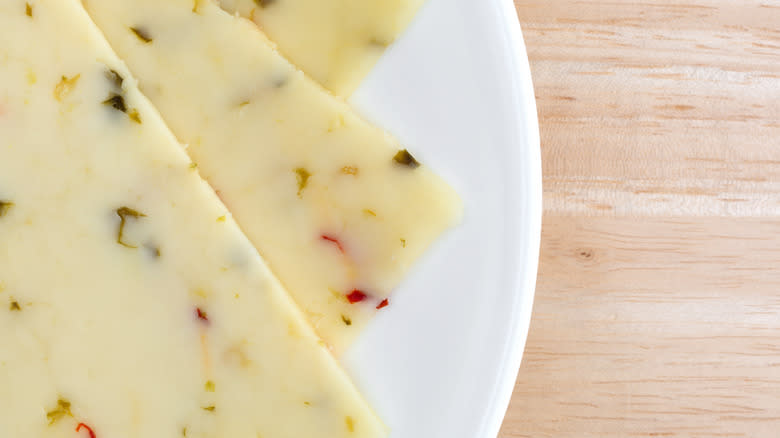
Pepper jack is renowned for its spicy character, owing its distinctive taste to the infusion of spicy jalapeño bits within the cheese. These fiery capsicums make pepper jack the ideal choice when you're in the mood to add some heat to your everyday ham sandwich. When paired, these ingredients complement each other perfectly. Not only does the cheese enliven the ham's saltiness, but the ham, in turn, tempers some of the cheese's more intense notes.
While the dynamite flavor combination steals the spotlight, don't underestimate the appeal of pepper jack's texture. Its open, melt-in-your-mouth quality makes it an ideal companion for grilled or toasted sandwiches. We recommend adding fresh ingredients like crisp lettuce, succulent tomato, and creamy avocado to your creation. These additions offer a refreshing contrast to pepper jack's heat, while still allowing the peppers to shine through. When it comes to bread, opt for something sturdy, like ciabatta or a rustic loaf, that's able to hold up to the bold flavors in this sammy.
Red Leicester
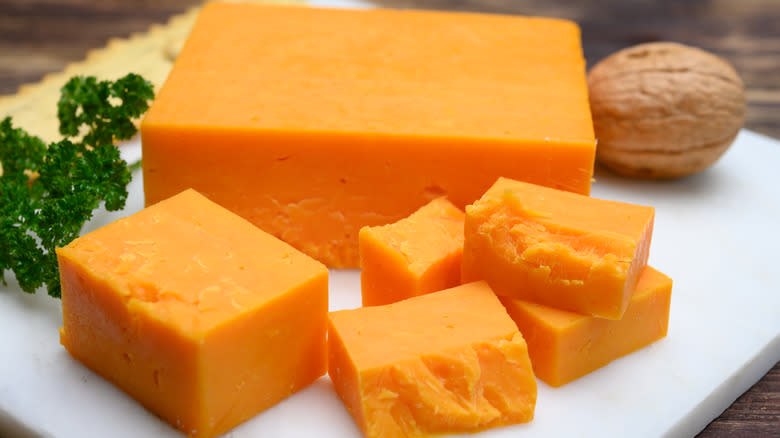
Hailing from the heart of Leicestershire, England, Red Leicester is a cheese as distinctive as its deep russet-red hue. This unusual color is no accident — it's achieved by the addition of annatto, a natural pigment derived from seeds of the achiote tree in Central and South America.
The use of annatto in cheese-making dates back to a time when this deep color was revered as an indicator of cheese crafted from rich, creamy milk. Red Leicester's uniqueness doesn't stop at its vibrant appearance. Its texture, unlike the cheddar cheese it's often confused with, is flaky and moist. Another difference between these two cheeses is the flavor. Whereas cheddar can be buttery or sharp (depending on the age), Red Leicester has a mild nutty flavor that caramelizes as it ages.
When it comes to ham sandwiches, Red Leicester has plenty to offer. Its savory, nutty notes effortlessly align with the saltiness of the ham, creating a balance of flavors sure to excite your taste buds. The cheese's crumbly texture adds an intriguing layer to the mouthfeel, enhancing the overall eating experience. Whether you choose to layer it on a rustic roll or incorporate it into a grilled panini, Red Leicester brings a luxurious dimension to your ham sandwich. To truly elevate your sandwich, consider adding caramelized onions, pickles, or a mild mustard to enhance the flavor profile.
Camembert
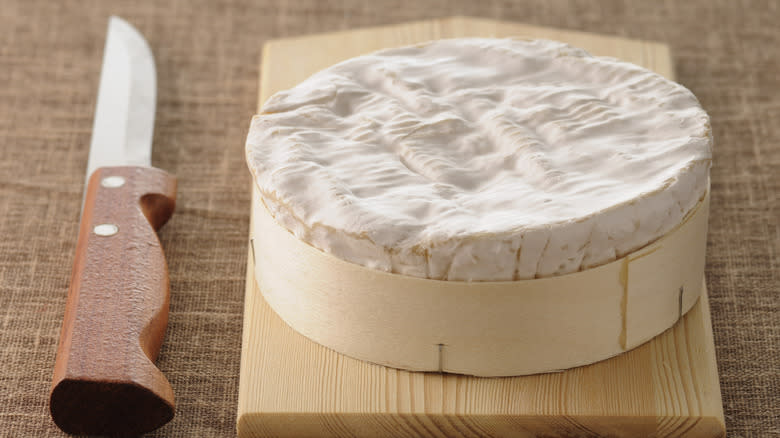
It's hard to stand out in a country known for its high fashion brands, world-class champagnes, and top-of-the-line beauty products, but somehow a humble cheese has managed to do just that. The cheese in question is Camembert, a soft-ripened cow's milk cheese from Normandy. What makes this seemingly basic cheese so extraordinary is its high butterfat content, bloomy rind, and runny texture. Put together, these features make Camembert an ideal addition when your ham sandwich calls for a touch of luxury.
Depending on how long it's been aged, Camembert features notes ranging from grassy and fruity to mushroomy and garlicky. These earthy, sometimes tangy flavors complement the salty, savory depth of the ham, adding a layer of complexity to an otherwise simple sandwich. On the textural front, Camembert's soft and creamy profile contrasts with the firmer texture of ham, creating a smooth, luxurious mouthfeel. Serve this winning combination on crusty bread, like a baguette or a French boule, along with a drizzle of honey or a smear of fig jam.
Emmental
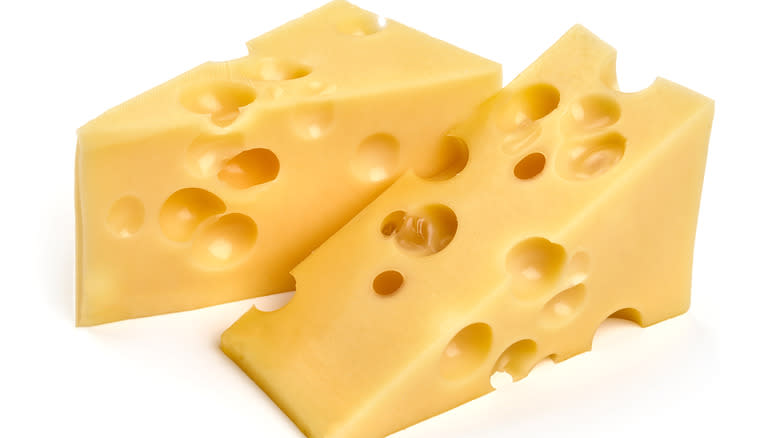
Emmental may be a Swiss cheese, but this isn't the kind you're used to buying from the supermarket deli counter. Unlike the baby Swiss you've got in the fridge, Emmental (also spelled Emmenthal, Emmentaler, and Emmenthaler), is aged for at least four months, giving it more pronounced nutty and fruity flavors. This prolonged maturation adds a depth of flavor perfect for pairing with salty ham.
While the flavor might be novel, the appearance isn't. You'll instantly recognize the large holes perforating this grass-fed cow's milk cheese. These holes add to the sandwich's visual appeal, making it as irresistible to your eyes as it is to your palate. Emmental's exceptional meltability enhances its allure, especially for toasted ham and cheese sandwiches. When melted, it turns delightfully smooth, enveloping the ham in its nutty richness. To really up the fanciness of your sandwich, add sliced red onions, a dab of berry jam, or a squirt of Dijon mustard.
Fontina
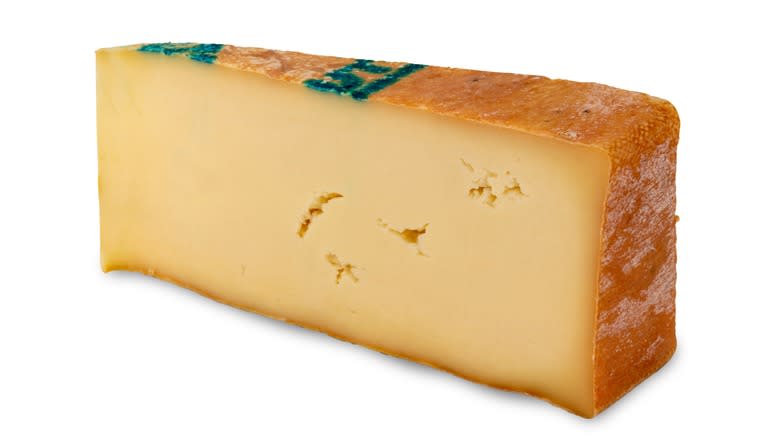
Many try to copy Fontina's magic, but unless you're purchasing a wedge made in the Aosta Valley in northern Italy, you've got an inferior imposter on your hands. Not that we blame these interlopers. After all, Fontina is one of the tastiest cheeses in Italy, if not the world. This semi-hard cow's milk cheese contains about 45% milkfat and has a flavor profile that ranges from mild and nutty to robust and mushroomy. These distinctive notes beautifully complement the smokiness of ham, creating a flavor experience that'll linger on your palate long after the first bite.
When it comes to recipes, try a hot ham and Fontina sandwich. Fontina, especially younger varieties, melts with ease and adds a creamy dimension to your sandwich. Throw some sun-dried tomatoes into the mix and you've got a sandwich fit for a summer lunch at an Italian villa. Alternatively, you can try melting it with ham over a mixture containing asparagus, green olive, herb, and lemon to create a lunch fit for the Bel Paese.
Read the original article on Tasting Table.

